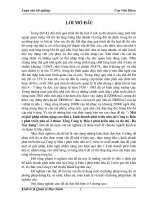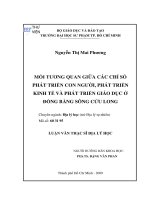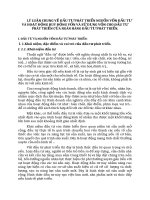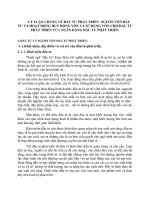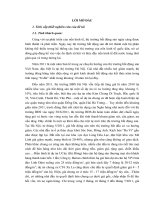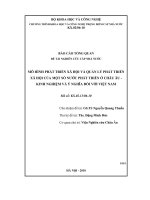SỰ PHÁT TRIỂN CỦA CÁC PHƯƠNG PHÁP ĐÁNH GIÁ NHU CẦU NGƯỜI HỌC TRONG TIẾNG ANH CHUYÊN NGÀNH: LÝ THUYẾT VÀ THỰC TIỄN
Bạn đang xem bản rút gọn của tài liệu. Xem và tải ngay bản đầy đủ của tài liệu tại đây (683.07 KB, 19 trang )
<span class="text_page_counter">Trang 1</span><div class="page_container" data-page="1">
<b>Sự phát triển của các phương pháp đánh giá nhu cầu người học trong tiếng anh chuyên ngành: Lý thuyết và thực tiễn </b>
<b>The Development of Needs Analysis Frameworks for English for Specific Purposes (ESP): Theory and Practice </b>
<i>Vu Thi Huong </i>
<i>Faculty of Education and Foreign Languages, Vietnam National University of Agriculture Ngo Thi Thanh Tam </i>
<i>Faculty of Education and Foreign Languages, Vietnam National University of Agriculture </i>
Nhu cầu của người học là vấn đề trung tâm trong thiết kế chương trình tiếng Anh chuyên ngành. Đã có một số mơ hình lý thuyết ra đời để giúp thực hiện việc đánh giá nhu cầu của người học trong các lĩnh vực chuyên môn khác nhau. Những phương pháp này đã và đang được sử dụng trong một số nghiên cứu về nhu cầu người học của tiếng Anh chuyên ngành nhằm định hướng cho việc thiết kế chương trình học trong các văn cảnh khác nhau. Bài báo này thảo luận đặc điểm của các phương pháp lý thuyết trong đánh giá nhu cầu người học và ứng dụng thực tiễn của chúng. Dựa trên việc phân tích các nghiên cứu gần đây về tiếng Anh chun ngành, chúng tơi cho rằng q trình đánh giá nhu cầu người học đang trở lên phức tạp hơn vì q trình này địi hỏi sự tham gia của nhiều bên liên quan. Sự đánh giá nhiều chiều có thể dẫn đến việc hình thành chương trình học phù hợp nhất cho người học.
<b>Từ khoá:, nhu cầu người học, nghiên cứu đánh giá nhu cầu, phương pháp đánh giá nhu cầu, </b>
Tiếng Anh chuyên ngành
<b>Abstract </b>
The specific needs of learners are the center of the curriculum design for English for Specific Purposes (ESP). There are a number of theoretical frameworks that can be used to guide ESP
</div><span class="text_page_counter">Trang 2</span><div class="page_container" data-page="2">practitioners to conduct needs analysis (NA) for English learners in specialist areas. These models have been used in various studies on NA for ESP to inform the design of programs in a wide range of contexts. This paper discusses the evolving nature of needs analysis (NA) theoretical frameworks and their practical application. Based on the analysis of recent studies in ESP, we argue that the process of needs analysis for ESP has become increasingly intricate as it needs to involve a range of stakeholders on the ground. This more multidimensional view of needs may result in a more defensible curriculum for ESP.
<b>Key words: ESP, Needs Analysis, NA models, NA research </b>
<b>1. Introduction </b>
This paper aims to demonstrate the relationship between the theoretical development in ESP Needs Analysis and the use of these theories in empirical studies over an 18-year period. This indicates that the area of NA is an evolving field of study, and of growing importance in global economics and trade. The long history of ESP parallels the increasing demands to meet the needs of specific groups of learners. Needs analysis, therefore, has a vital role in the ESP. Some well-known models for conducting needs analysis for ESP courses have been developed and used to serve the purpose of identifying the linguistic categories and tasks required for learners in a target setting such as a workplace. Although the models share a common goal of clarifying needs to inform ESP course design, they reflect varying views on learners’ needs and the components required in the needs analysis process. The most recent models have been strongly influenced by the earlier frameworks but also attempt to be pragmatic in the ways they take into account different sources of information and perspectives from stakeholders to negotiate the most appropriate syllabus for an ESP program.
In an attempt to give a clearer picture of development of NA models in ESP both in theory and practice, we firstly provide a brief summary of theoretical frameworks for NA in ESP including their main focus and their outcomes. Following this summary, we report on a survey of twenty NA studies in the field of ESP from 2000 to 2018 to evaluate the application of the above theoretical models in a variety of contexts.
<b>2. ESP origin and development </b>
</div><span class="text_page_counter">Trang 3</span><div class="page_container" data-page="3">ESP emerged under the umbrella of the Language for Specific Purposes (LSP) movement in the second half of twentieth century (Dudley-Evans & John, 1998; Hutchison & Waters, 1987; Richard, 2001). Factors contributing to the spread of ESP are the prosperity of the world economy, significant changes in the field of applied linguistics towards real language use for communication instead of formal language features and the development through educational psychology of learner-centered approach (Hutchison & Waters, 1987). Traditionally, ESP was related to science, technology and business (Dudley-Evans & St. John, 1998). Much attention was paid to lexical and grammatical aspects (Swales, 1988). Technical vocabulary and specialized text translation used to be common tasks for students to deal with in ESP classrooms. ESP is now integrated into wide range of disciplines. Many tertiary institutions are paying more attention to helping their students meet the demands of a globalized job market (Torres & Burbules, 2000). As a result, there is an increasingly high demand for ESP programs in colleges, universities and vocational schools (Anthony, 1997).
There is no universal definition of ESP. Different approaches to ESP through its development over the last half of century have also led to distinct ways of defining this branch of English language teaching. Hutchison and Waters (1987) believed that ESP is an approach, instead of a product, and defined it as a course which designed to meet the needs of learners. In other words, ESP does not necessarily involve a particular kind of language, teaching material and methodology. This way of viewing ESP is also supported by Robinson (1980). Robinson argued that ESP means the teaching of English to learners who have a specific reason for learning the language. Learners may learn an additional language to serve their professional, academic or scientific purposes. Dudley-Evans & St. John (1998) listed the main characteristics of ESP (below) and Strevens (1988) provides a similar list.
<small>Fixed Characteristics of ESP (Common to all ESP courses) </small>
<small> ESP is defined to meet the specific needs of the learner; </small>
<small> ESP makes use of the underlying methodology and activities of the discipline it serves; </small>
<small> ESP is centered in the language (grammar, lexis, register), skills, discourse and genres appropriate to these activities. </small>
<small>Variable Characteristics of ESP (Characteristics which may or may not be present) </small>
<small> ESP may be related to or designed for specific disciplines; </small>
</div><span class="text_page_counter">Trang 4</span><div class="page_container" data-page="4"><small> ESP may use, in specific teaching situations, a different methodology from that of general English </small>
<small> ESP is likely to be designed for adult learners, either at a tertiary level institution or in a professional working situation. It could, however, be used for learners at the secondary school level; </small>
<small> ESP is generally designed for intermediate or advanced students; </small>
<small> Most ESP courses assume some basic knowledge of the language system. (p.4-5) </small>
Huhta et al. (2013) added another two defining characteristics of ESP namely
<small> ESP is evidence-based; </small>
<small>ESP is specific to the professional context not the professional domain (p.36)</small>
More recently, Belcher (2006) defined ESP by the terms “needs-based”, “pragmatic”, “efficient”, “cost-effective” and “functional” (p.134), while Richards & Schmidt (2010) offered a widely-used definition of ESP as “the role of English in a language course or program of instruction in which the content and aims of the course are fixed by the specific needs of particular group of learners” (p.198). It is obvious that the definitions (above) have much in common as specific needs of a particular group of learners are placed at the center of ESP courses.
Brown (2016) set our different subcategories of ESP in a fourlevel frame that was mainly based on the classification proposed by Dudley-Evans and John (1998). ESP involves two main areas, which are English for Academic Purposes (EAP) and English for Occupational Purposes (EOP). These categories are further subdivided into distinct disciplines.
</div><span class="text_page_counter">Trang 5</span><div class="page_container" data-page="5"><i>Figure 1. Different types of ESP (Brown, 2016, p.7) </i>
<b>3. NA in ESP curriculum </b>
NA is a data collection process (Nunan, 1988). It is often seen as the defining characteristic of ESP (Basturkmen, 2010) as it makes ESP different from General English (GE), which often has no specific purposes. Numerous researchers (Belcher, 2006; Dudley-Evans & John, 1998; Hutchison & Waters; 1987, Robinson, 1991) have highlighted the importance of needs assessment (NA) as a prerequisite in the ESP program design process. Course designers conduct needs analysis to gather and analyze information, then use it to inform instructional curriculum. Needs analysis can map the ESP program by identifying tasks that are needed by a particular community. It can also provide criteria for evaluating tasks performance (Malicka, Guerrero & Norris, 2019). Kim (2008) reported from his experience that the graduates functioned well in their work place as “they were equipped with the language skills that were selected, prioritized, sequenced, taught and evaluated based on their specific needs” (p13.) In other words, knowing learners’ needs is the fundamental principle of ESP curriculum design and development.
<i>Michael West first used the term “analysis of needs” in 1920s to explain why and how students should learn English. Until today, needs analysis remains an ambiguous term. There is </i>
no fixed definition of it because the scope of needs analysis has changed and expanded (West, 1997). On the one hand, there have been some straightforward approaches to NA. James (1974)
</div><span class="text_page_counter">Trang 6</span><div class="page_container" data-page="6"><i>viewed needs analysis as an examination of real and imaginary needs, demands, requirements, </i>
expectations and use. Ellis (2003) provided another simple way to see NA when he defined it as a process for determining the specific needs of language leaners. Several researchers, on the other hand, describe NA in a more complicated way. Brown (2016) reminds us that NA involves different stakeholders, thus it means different things to learners, teachers, administrators,
<i>institutions and employers. Chambers (1980) and Richards (2001) separated the terms needs and analysis and drew a conclusion that that the terms can cause confusion and questions both when they go together and when they are separated. Needs commonly refers to linguistic deficiency. </i>
However, the term may relate to other types of needs in some cases. Needs are not seen as a ready-made thing but one that needs to be shaped. Associating needs analysis and the Common European Framework (CEF) Professional Profile, Huhta and his colleagues directly adopted the more comprehensive view of NA of Brown (2006), who included both different sources of information and stakeholders in NA process.
<small>Needs analysis is the systematic collection and analysis of all subjective and objective information necessary to define and validate defensible curriculum purposes that satisfy the language learning requirements of students within the context of the particular institutions that influence the learning and teaching situation. (p.102) </small>
These distinct approaches to needs assessment have led to the development of several NA models that may be used by researchers and ESP practitioners to conduct an investigation into needs to bridge the gap between language classrooms and actual professional domains.
<b>4. The Development of NA Models </b>
The significant development of ESP over the last fifty years has coincided with the emergence of several models for conducting thorough needs analysis as a starting point in course design, leading to the development of specialized language modules. In this section, I will trace the development of various models to show how NA has evolved. Huhta et al. (2013) assert that the history of needs analysis can be separated into, what they called, the first and second generation. The first generation focused on language skills, functions and lexis whereas the later one is task-oriented. The work of Munby (1978), Hutchison & Waters (1987) and Dudley-Evans
</div><span class="text_page_counter">Trang 7</span><div class="page_container" data-page="7">and Johns (1998) resulted in a list of language skills and functions needed in target contexts. Later, Huhta et al. (2013) and Brown (2016) adopted a different approach to needs analysis which was more practical and multidisciplinary in application as they aimed to identify tasks learners were required to master in their occupational discourse.
The emphasis and scope of each of these models are summarized in the table 1 below.
Necessities, Lacks and Wants (Objective and subjective needs)
Target needs and learning needs analysis involving answering questions about language learning
The purpose (why)
The target group of learners (who)
The setting (where) The time (when) The content (what) The mean (how)
8 parameters are used to gather and analyze information about the learners and stakeholders Personal information about
Language learning needs How to communicate in the
</div><span class="text_page_counter">Trang 8</span><div class="page_container" data-page="8"><i>Table 1. Needs Analysis Models in ESP </i>
As can be seen, a number of models for needs assessment have been developed along with the recent widespread of ESP. The later models have been much improved as they were based on the previous frameworks, yet wider and deeper in their scope. Although the first generation of NA has had a strong influence on NA development, it has been criticized by many researchers. Munby’s approach results in a detailed and informative profile of learners’ needs but it is said to be complex and inflexible (West, 1997) as well as costly and impractical (Ha, 2005). Besides, Munby ignored the perspectives of teachers, learners and sponsors (Hutchison & Waters, 1987).
</div><span class="text_page_counter">Trang 9</span><div class="page_container" data-page="9">Similarly, Hutchison and Waters’ approach to curriculum design was mainly language-based as linguistic features are their focus (Huhta et al., 2013). Rahman (2015) also pointed out some shortcomings of the framework when claiming that learners’ subjective needs do not always align with learners’ real needs to operate well in the target situation. Furthermore, Hutchison and Waters did not take into consideration means analysis, linguistic analysis, discourse analysis and genre analysis. Dudley-Evans and St. John (1998) presented a more practical and pragmatic model which takes into account all the aspects of target situation analysis, present situation analysis, learning situation analysis, means analysis (Rahman, 2015). However, as a part of the first generation, their framework also focuses on the linguistic aspect of ESP syllabus (Huhta et al., 2013).
The second generation of NA, on the other hand, tends to specify communicative tasks and situations with which learners have to be familiarized so that they can function well in their profession. Huhta et al (2013) and Brown (2016) established the most up-to-date NA models that provide a holistic solution to the issue of NA in ESP course design with a thorough need analysis process which gather information from multiple sources using multiple methods to inform course content (Serafini, Lake & Long, 2015). While Huhta and his peers introduced procedures in conducting needs analysis, which are flexible and can be applied in different contexts as well as potential for an ESP course to better meet the true needs of learners (Hadley, 2014), Brown’s new approach helps to build a complex theoretical background as well as practical tools to carry out NA (Douglas, 2017).
<b>5. NA in Practice </b>
In this section, I have selected twenty research papers on needs analysis for ESP, which were published from 2000 to 2018. These studies were selected because they are indicative of the applications of the theoretical frameworks in NA in ESP. More specifically, the studies came from a range of contexts, used different NA models, had different research participants and methods. Although they were all investigating NA, they had a number of different foci. These were clustered around: language needs, professional communicative needs or both. The research work is also arranged in chronological order so that their potential significance is made clear.
</div><span class="text_page_counter">Trang 10</span><div class="page_container" data-page="10">NA has been conducted widely for ESP courses within varying disciplines such as business, engineering, heath science, tourism, information technology and agriculture. This is the obvious because of the increasing importance of English as a lingua franca and the language of world science.
The research studies in this survey adopted particular theoretical frameworks to carry out NA. However, there were some researchers who developed their own framework on the basis of the previous studies. In addition, the tools (questionnaires or NA frameworks) of these studies have been also utilized in other smaller scale research. For instance, Balaei and Abhour (2017) used a needs analysis questionnaire in the study of Moattarian and Tahririan (2014) to investigate the language needs for information technology students in a university in Iran. Table 2 indicates that research work on NA in ESP in the early 2000s mostly used a the learner-centered approach of Hutchison and Waters (1987). This approach has three NA parameters namely lacks, wants and necessities. The NA model of Dudley-Evans and Johns (1998) then added means analysis in NA. This newer version of ESP NA was preferred in the later studies. Interestingly, there is a recent trend to conduct NA to identify professional communicative needs. These are the core component of CEF Professional Profile in Huhta’s model. This change can be explained by the improvement of the later NA models as the more recent model is more complete and take into consideration all the important factors in relation to learners, institutions and employers for a more thorough NA process.
</div>

